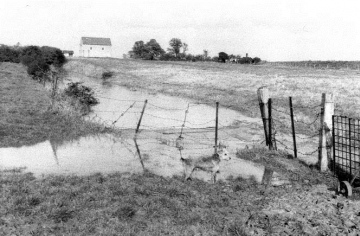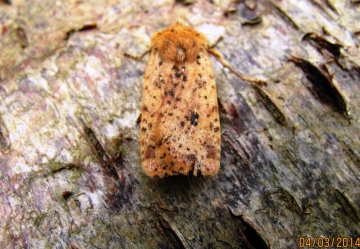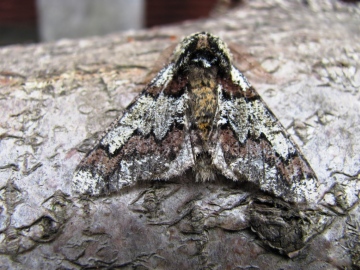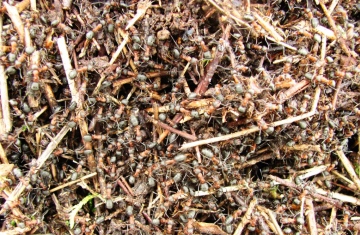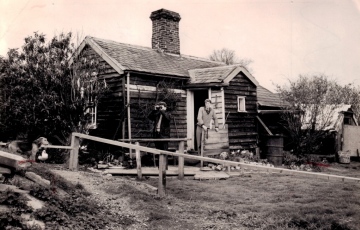 Linnet's Cottage ca 1960. Kevin Bruce in doorway
Linnet's Cottage ca 1960. Kevin Bruce in doorway
If there is anyone out there I thought you might like to see these old photographs of Bradwell St Peter’s and Linnet’s Cottage. They were taken in the 1950s by Kevin Bruce, a local historian and founder member (in 1953) of Bradwell Bird Observatory, and he has kindly allowed me to use them here. The cottage was built around 1798 by the Admiralty in order to house two naval officers - a lieutenant and a midshipman – whose job it was, along with two ordinary seamen, to man a signalling station on high ground nearby. The boredom engendered by the site’s isolation, coupled with having to live cheek by jowl in cold cramped quarters, not to mention the ever present threat of being laid low by the dreaded Essex ague (a form of malaria) must have made this the posting from hell. A surviving letter from November 1810 written by one Lieutenant John Leckie to their Lordships about the midshipman under his command states that:
“…….he went from the station without asking leave and stayd all night, did not return until nine this Next morning, and was then obliged to go to bed; I talked to him on that business, and he told me that he did not know that he was supposed to ask leave but promised to do so no more, on Thursday last he asked leave to go up to the village which he did, on the next morning he asked leave again which I granted him, and last evening he went away again without leave, and did not return again until one past ten, this forenoon and so drunk, that he went to bed immediately, he is without exception the most stupid man I ever had or saw……..â€
Winters must have been fun in such company! At the end of the Napoleonic wars the signal station was closed down. The Linnet family are thought to have taken up residence in the middle of the century and remained in occupation until 1958 when the last member of their family to live there, Walter Linnet, died at the age of 80.
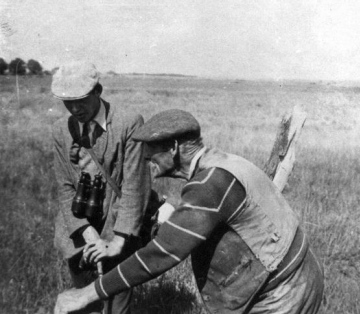 Walter Linnet with Rod Larner, another founder member of the Obs
Walter Linnet with Rod Larner, another founder member of the Obs
The Linnet’s were among dozens of professional wildfowlers (or Marsh Men as they were then known) along the Dengie coast who made a living from shooting wildfowl and waders, fishing, ‘cockling’, and harvesting Marsh Samphire and other products of the estuary. Walter and his wife raised eight children in this tiny cottage and it is rumoured that the babes in arms were put to bed in boxes in the cupboards. From the moment they could toddle much of their lives would have been spent out of doors. Walter’s father is likely to have been among the thirty-two punt gunners who are reputed to have fired simultaneously into a flock of Brent Geese on the Dengie flats in around 1860, killing at least 704 of them. Several other huge bags of geese were also reported from the area at around this time. The same era saw over 3000 Lapwing eggs sent to market one summer from a single Norfolk estate alone, not just the original clutch of each pair being taken but all the replacement clutches as well. They didn’t allow sustainability to get in the way of short term gain in those days either!
The photo above depicts the cottage and nearby St Peter's Chapel as I remember them when I first visited the area in 1965. The ditch in the foreground was an old tank trap, built during the 1939-45 War and was known as Twite Ditch on account of the Twite, or Mountain Linnets, that used to flock there to drink in the winter months. Cattle still grazed the meadows in those days but in the late 1960s progressive son took over from backward father and within a few months the meadow had been ploughed, the ditch filled in and all the many hedgerows on the farm grubbed out. Even a solitary bramble bush was not spared and one day I watched a bulldozer trundle all the way from the farm and make an almost comically frenzied assault on it - like something out of Monty Python. It made me wonder who or what the driver had in mind while attacking it!
Anyway, spring is still progressing well on many fronts. At Blue House Farm the Lapwings are now on territory on Round Marsh - the main wader breeding area - including this fine male. With a crest like this it is no wonder he has the pick on the territories and the females!
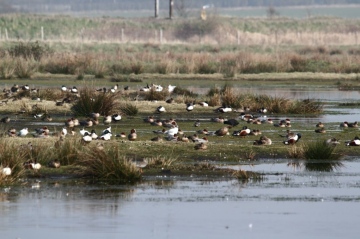 Round Marsh, Blue House Farm - John Lilley
Round Marsh, Blue House Farm - John Lilley
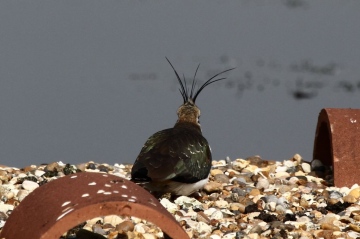 King of the island! - John Lilley
King of the island! - John Lilley
It has been a great spring so far for butterflies and we counted 45 Small Tortiseshells and 39 Peacocks between St Lawrence Bay and Marshhouse Outfall during our monthly WeBS count on 16th. There were also over 300 Black Oil Beetles along one short stretch of south facing seawall at Sandbeach Outfall on 9th; so many in fact that it was difficult to avoid treading on them. For such a specialised insect it is remarkable how successful they are along this coast. At Blue House a Red Kite was seen on 5th and the first Wheatear moved through on 19th while we caught this Essex RDB species, a Dotted Chestnut, also on 5th. Grassland with trees appears to be its preferred habitat but no-one seems quite sure what its caterpillars feed on. A much commoner but no less beautiful species is the Oak Beauty, one of many moths caught in the garden kin the past fortnight.
All in all the season is flowing well, certainly compared to 2013 when three months of Russian easterlies set everyhing back by a month or more. I doubt whether the smaller inhabitants of North Heath EWT Reserve, Little Baddow will be having a very good spring though, especially if they encounter these Wood Ants, one of dozens of nests that were slowly coming back to life as we worked around them on the first day of the month.
























